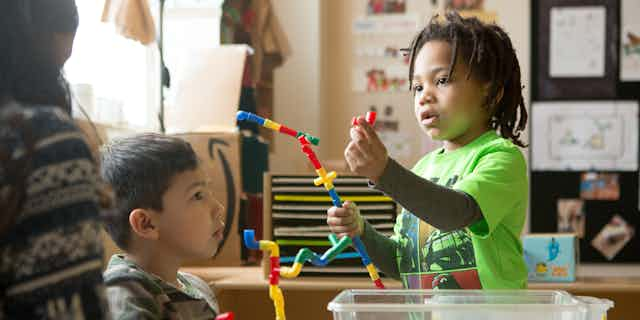This fall, many young children across Canada have entered early learning or preschool programs for the first time.
Access to early learning is a challenge across the country — and many parents scramble to find a space for their children.
But there are some programs that are readily available and accessible to all children in their catchment areas. In Nova Scotia, an investment in universal early childhood education is happening through the “pre-primary program,” housed in primary schools. This is similar to what is currently offered as play-based junior kindergarten in schools in both Ontario and the Northwest Territories.
As many parents or caregivers drop their young children off at a “big school” they may wonder: What should I be looking for in this program? What makes it a high-quality program? Our team took a closer look at what constitutes high quality in these publicly funded, school-based settings.
Differences in early learning programs
There are many similarities between regulated early learning and child-care settings and early learning programs offered in schools. Both are expected to follow a play-based curriculum, and both have qualified early childhood educators working with these children in the year or years before they begin more formal school grades. However, there are differences as well.
What defines quality in this specific setting is not a straightforward process, given its unique characteristics. For this reason, we need to consider broader system factors, in addition to structural characteristics (like child-staff ratios, group size, training) and process considerations, including people’s interactions, routines and activities.
Through a systematic process, we examined existing literature about quality in early childhood school-based programs. This included consultation with international experts and searching literature databases.

We found 6,335 possible sources, and a rigourous screening process helped to identify the most relevant studies. Our final review focused on 41 sources, which informed an expanded image of what high-quality means in school-based early childhood programs like pre-primary and kindergarten. We propose that identifying high-quality should include considering internal and external influences on quality programming, and that it’s important to examine themes of policies, practice, place and people.
Policies
Policies that govern publicly funded, school-based early learning programs are foundationally important. Sustainable funding, adhering to regulations, government investment and ongoing assessment and evaluation of children’s learning are key to providing quality programming.
Read more: Kindergarten scrapbooks aren't just your child's keepsake — they're central to learning
Ongoing, planned and well-resourced assessment and evaluation of such programs could also contribute to supporting high-quality practice by determining if programs are reaching goals and effectively using their funding.
Practices
Practices that support high-quality programs include following a teaching and learning approach that is responsive to children’s ways of learning — for example, using a play-based approach that supports exploration and self-expression.
Other practices that early childhood experts identify as indicating high quality include low adult-to-child ratios and small class sizes depending on the individual support needs of children within the classroom.
In addition to group size, warm, responsive and positive relationships between educators and children are critical to supporting adults and children’s joint attention and sustained shared thinking.
Research also identifies that the extent to which programs support and promote inclusion and diversity is related to program quality.
“Inclusion” refers to the acknowledgement and celebration of diverse abilities, cultural and linguistic backgrounds and family structures. It also means policy support designed to mitigate adversity arising from low socio-economic family circumstances by offering affordable spaces, lunch programs and other services to assist families with young children. As well, it refers to any additional or specialized service supports that are provided to children and families.
Place
The location and the time spent in the learning environment, as well as the structure of the learning environment itself, are all considered important components of quality. Schools provide stable infrastructure for programming and allow for potential collaborations between early childhood educators and teachers.
The time spent in the program, or “dosage,” is an important component of quality as well. The more time spent in a quality early learning program in the year prior to mainstream elementary school, the more likely there will be positive outcomes for children.

People
The people who work in pre-primary or junior kindergarten programs in schools greatly influence the quality of the program being offered.
Educators’ level of post-secondary education specific to early childhood education is a major indicator of positive developmental outcomes for children. More formal qualifications and ongoing professional development are often related to better-quality programming.
Read more: Canada's COVID-19 child-care plan must start with investing in early childhood educators
Given the placement of these programs in schools, support from administrators, principals and teaching assistants also influence the quality of programming, along with the involvement of families and communities.
Educators become more aware of families’ perspectives of quality as parents, families and community members are welcomed to participate in an early learning setting at a level that is possible for them in terms of their resources and availability. Educators gain knowledge of the cultural and social contexts of the children in their program.
As another school year unfolds, the first for many young children entering school-based early learning programs, our review provides insight into some considerations for implementing these programs to ensure they are offered in a high-quality manner to support children and families.

